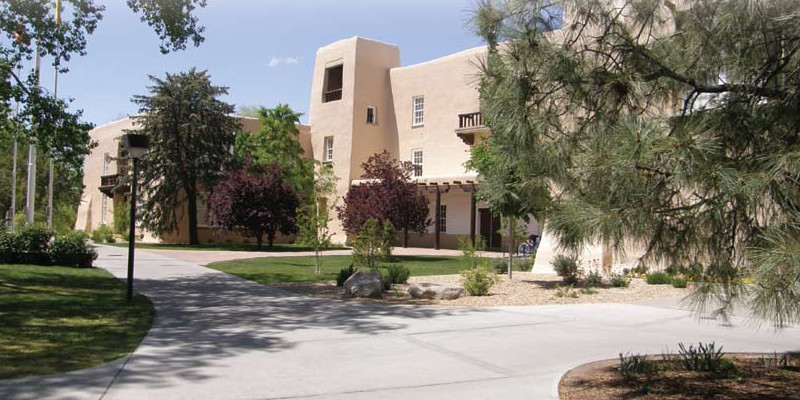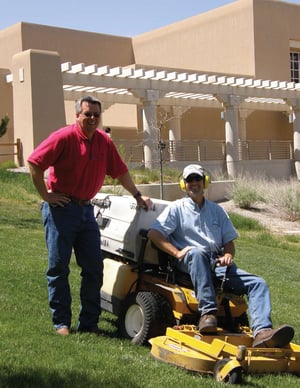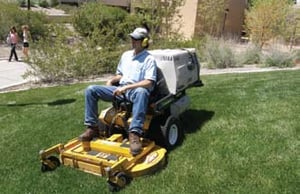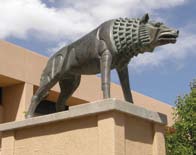Your son or daughter plans to tour the University of New Mexico (UNM) in Albuquerque. What can he or she expect to see? Southwestern architecture and an abundance of cacti and native landscape? You would be right on the first count, but wrong on the second.
UNM’s campus features an interesting blend of Pueblo Revival architecture, but it is as green as its more northern peers. In fact, the entire 680-acre setting is a nationally recognized arboretum, with an abundance of beautiful trees, 302 acres of landscaping and 55 acres of turf.

Maintaining the campus is the responsibility of Grounds and Landscaping Manager, Willie West. In addition to keeping the landscaping in top shape for the school’s 32,000 students, West’s staff also oversees a 1,000-zone-plus irrigation system; runs the sign, welding and small engine repair shops; manages staff and faculty moves; coordinates special events; performs all of the campus refuse removal; and spends more than 200 hours a week removing litter and trash from the grounds, among other responsibilities.
“One of our biggest challenges here is the sheer number of people,” says West, who joined the UNM grounds staff in 2002 after working for two area landscaping companies. “In addition to students, there are several thousand faculty and staff members, not to mention a huge number of visitors daily. UNM also hosts 300 weddings a year and a number of other events that need to be coordinated.” West goes on to explain that the school is home to the state’s only Level One Trauma Center. Needless to say, West and his staff are busy year-round.
Turf Talk
Of West’s 65 staff members, 51 are dedicated to maintaining the grounds. Mow crews are busy four days a week for nearly 10 months out of the year. They head out Monday mornings with three Walker Mowers (one with a 36-inch GHS deck and two with 48-inch GHS decks), two wide-area mowers (a 72-inch Exmark and a 72-inch Jacobsen) and a couple of Exmark 21-inch walk-behind mowers.
 “I have been using Walker Mowers since 1988, and I thought they would be perfect for this application,” West explains. “They’re compact, maneuverable and stable—something we require for our undulating terrain. I’ve always liked their mowing pattern. We also use several attachments, including the aerator, snowplow and dethatching rake. We’ve discovered that the rake has a dual purpose on campus; in addition to removing thatch, it is also ideal for gathering pine needles.”
“I have been using Walker Mowers since 1988, and I thought they would be perfect for this application,” West explains. “They’re compact, maneuverable and stable—something we require for our undulating terrain. I’ve always liked their mowing pattern. We also use several attachments, including the aerator, snowplow and dethatching rake. We’ve discovered that the rake has a dual purpose on campus; in addition to removing thatch, it is also ideal for gathering pine needles.”
West says his two wide-area mowers are necessary for mowing areas like Johnson Field, a large, all-purpose venue that hosts concerts, rallies, intramural sporting events and other outside events. Both mowers, he notes, have excellent ground speed and offer good visibility for operators, a very important attribute when mowing on a busy campus.
Also important when mowing and maintaining a campus is timing. Crews strive to maintain landscaping and turf that’s adjacent to classrooms early in the morning. Then they head to the dorms mid-morning while students are attending classes. The use of low-decibel Stihl and Echo backpack blowers helps minimize invasive noise.
Greener Yet
UNM’s grounds manager asks this question: “If you were a student, would you rather sit around outside on a desert floor surrounded by cacti, or be enveloped by green grass and shade trees?” The answer is obvious, yet Albuquerque’s difficult hardiness transition zone and the school’s foot traffic pose a few unique challenges.
“Winters can be mild and produce little snow, or they can be tough like the one we had two years ago,” West relates. “That’s when we had 22 inches of snow in one day and the city was shut down for a week. We kept the school open, but not without a struggle.
“ This is not the ideal environment for Bermuda grass, which goes dormant for six months and doesn’t hold up well under a lot of activity. Instead, most of our turf is comprised of a hardy, bluegrass/rye mix that is green and inviting nearly 10 months a year. The unpredictable weather, including the strong winds like we have today, can be tough on landscape plantings, too.”
This is not the ideal environment for Bermuda grass, which goes dormant for six months and doesn’t hold up well under a lot of activity. Instead, most of our turf is comprised of a hardy, bluegrass/rye mix that is green and inviting nearly 10 months a year. The unpredictable weather, including the strong winds like we have today, can be tough on landscape plantings, too.”
West explains that the university has a mandate from the state and university president, Dr. David Schmidly, to become a leader in the sustainable landscape movement. Although the arboretum setting already keeps the school’s carbon footprint small, West and his staff are looking for ways to make it even smaller. He plans to try out a couple of mulching decks on his Walker Mowers this year, and the school is gearing up to use alternative fuels in more of its fleet of trucks, cars and utility vehicles.
Water conservation is a big issue in Albuquerque. Upgrading UNM’s irrigation system with technological enhancements is ongoing and has already saved millions of gallons of water a year. “The savings in dollars may not be that much, but it’s the principle and a big step in the right direction,” adds West. “The school and the city currently get their water supply from a huge underground aquifer through a series of wells. There’s plenty of water now, but studies indicate that the aquifer is shrinking. Conserving water, along with plans to utilize water from the Rio Grande, will help ensure the water supply for years to come.”
Old vs. New
UNM is 110 years old, and West shares some of its natural and manmade highlights on a tour of the campus. “The Duck Pond,” he points out, “is a popular gathering place for students, and alumni often choose the site for weddings. Notice the faculty member holding class to our left. This is a typical sunny afternoon at UNM, and teachers often take advantage of the green grass, shade and beautiful weather to hold classes outside.”
“This is our new architecture building,” West goes on to say as our utility vehicle passes by a very large, modernlooking structure. “Unlike most of the older buildings on campus, this one features lots of open space inside. But I still prefer the old architecture.”
The oldest building on campus, now Alumni Hall, was built in 1909. West stops for a short visit there, and then provides a quick tour of the library—an interesting contrast of old and new. In the newer section, students employ computer technology to conduct their research and prepare for classes. A short walk to the old part leads to several small reading rooms and a great hall highlighted by hand-crafted beams.
Outside once again, West winds the vehicle along a shaded pathway, now and then finding a small area of turf under stress. Ever protective of the campus landscaping, he muses that sidewalks shouldn’t be poured until well after a new structure is up and running. After all, he says, students will ultimately find the best way to navigate around the building, and it likely won’t coincide with the builder’s plan.
 His last stop is at the statue of the college mascot, The Lobo (Mexican wolf ), and then it’s back to his office.
His last stop is at the statue of the college mascot, The Lobo (Mexican wolf ), and then it’s back to his office.
When asked to compare working for a university to working in the private sector, West shrugs his shoulders and says, “Yes, there are differences. In the private sector, there are sales goals to meet and changing market conditions. You don’t have that in a university setting, at least not in my department. Customers are different, as well. Large universities such as UNM have a cross section of students, faculty members and visitors. And, as I mentioned earlier, their sheer number creates a challenge for our grounds staff.”
West emphasizes that in both environments, though, customers share a common bond: an appreciation for well-landscaped and maintained grounds.




 Site Search
Site Search



